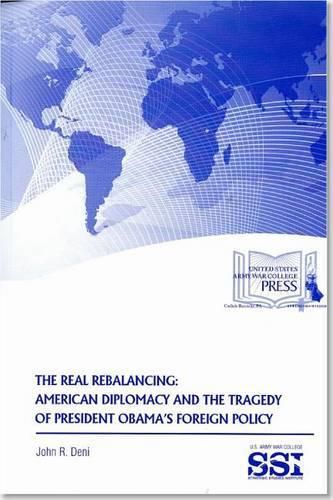Readings Newsletter
Become a Readings Member to make your shopping experience even easier.
Sign in or sign up for free!
You’re not far away from qualifying for FREE standard shipping within Australia
You’ve qualified for FREE standard shipping within Australia
The cart is loading…






American security policy rests on a three-legged stool consisting of defense, diplomacy, and development. As President Obama implied in his May 2014 speech at West Point, the United States is in the midst of a resurgence of diplomacy and development, as it seeks to leverage diplomatic influence, foreign aid, and multilateral institutions to solve the most vexing international security challenges. However, the dramatic rebalance toward diplomacy and development over the last several years has largely has failed. Rhetoric, official strategies, and actual policies have all aimed at rebalancing the three legs of the foreign policy stool. However, several factors point to a continued militarization of U.S. foreign policy, including funding levels, legal authorities, and the growing body of evidence that civilian agencies of the U.S. Government lack the resources, skills, and capabilities to achieve foreign policy objectives. Continued reliance by senior decisionmakers at both ends of Pennsylvania Avenue on the U.S. military in the development, planning, and implementation of U.S. foreign policy has significant implications. Foremost among them is the fact that the military itself must prepare for a future not terribly unlike the very recent past. AUDIENCE: Historians, policymakers, political scientists, and international affairs personnel may be interested in this guide that analyzes the rebalancing of American diplomacy within the Asia-Pacific region during Present Barack Obama’s administration.Additionally, students pursuing course work in military science and international relations degree programs may also be interested in this work.
KEYWORDS: Iran; United Nations Security Council; United States; U.S./US; Russia; U.S.S.R./Soviet Union; United Kingdom; UK; China; Germany; President Barack Obama; President Obama; foreign diplomacy; Hezbollah; Israel; President George W. Bush; U.S. national security; Iraq; Iran; Ukraine; Poland; Latvia; Estonia; Lithuania; Afghanistan; Israel; Iran’s nuclear program; counterterrorism; Secretary of State Hillary Rodham Clinton; Secretary of State, John Kerry; U.S. National Defense; U.S. Department of Defense; DOD; U.S. defense budget appropriations; U.S. Federal spending; international affairs; global terrorism; Al-Qaeda; Yemen; Africa; Pakistan; Syria;
$9.00 standard shipping within Australia
FREE standard shipping within Australia for orders over $100.00
Express & International shipping calculated at checkout
American security policy rests on a three-legged stool consisting of defense, diplomacy, and development. As President Obama implied in his May 2014 speech at West Point, the United States is in the midst of a resurgence of diplomacy and development, as it seeks to leverage diplomatic influence, foreign aid, and multilateral institutions to solve the most vexing international security challenges. However, the dramatic rebalance toward diplomacy and development over the last several years has largely has failed. Rhetoric, official strategies, and actual policies have all aimed at rebalancing the three legs of the foreign policy stool. However, several factors point to a continued militarization of U.S. foreign policy, including funding levels, legal authorities, and the growing body of evidence that civilian agencies of the U.S. Government lack the resources, skills, and capabilities to achieve foreign policy objectives. Continued reliance by senior decisionmakers at both ends of Pennsylvania Avenue on the U.S. military in the development, planning, and implementation of U.S. foreign policy has significant implications. Foremost among them is the fact that the military itself must prepare for a future not terribly unlike the very recent past. AUDIENCE: Historians, policymakers, political scientists, and international affairs personnel may be interested in this guide that analyzes the rebalancing of American diplomacy within the Asia-Pacific region during Present Barack Obama’s administration.Additionally, students pursuing course work in military science and international relations degree programs may also be interested in this work.
KEYWORDS: Iran; United Nations Security Council; United States; U.S./US; Russia; U.S.S.R./Soviet Union; United Kingdom; UK; China; Germany; President Barack Obama; President Obama; foreign diplomacy; Hezbollah; Israel; President George W. Bush; U.S. national security; Iraq; Iran; Ukraine; Poland; Latvia; Estonia; Lithuania; Afghanistan; Israel; Iran’s nuclear program; counterterrorism; Secretary of State Hillary Rodham Clinton; Secretary of State, John Kerry; U.S. National Defense; U.S. Department of Defense; DOD; U.S. defense budget appropriations; U.S. Federal spending; international affairs; global terrorism; Al-Qaeda; Yemen; Africa; Pakistan; Syria;